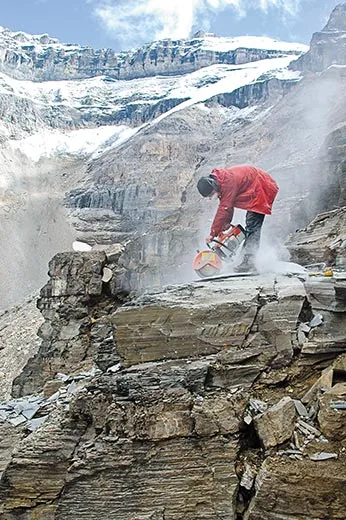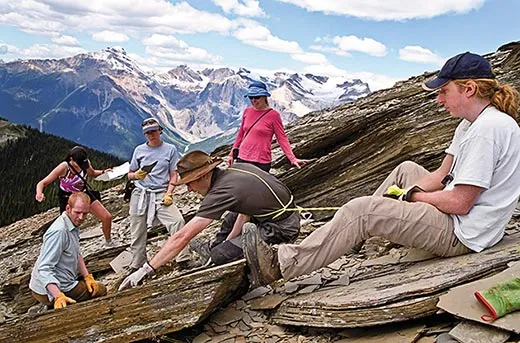The Burgess Shale: Evolution’s Big Bang
A storied trove of fossils from a Canadian paleontological site is yielding new clues to an explosion of life on earth
/https://tf-cmsv2-smithsonianmag-media.s3.amazonaws.com/filer/Jean-Bernard-Caron-colleagues-quarry-631.jpg)
The fossil-hunting expedition began with a lung-busting hike, accompanied by an incessant ring-ding-ting-clank-clank-ring-ting-ding-clank. The soundtrack came courtesy of an anti-bear bell attached to the backpack of the group's leader, Jean-Bernard Caron, a curator of invertebrate paleontology at Toronto's Royal Ontario Museum. After four hours of hiking up switchbacks through an evergreen forest deep in the Canadian Rockies, Caron suddenly took off like a mountain goat. As the others caught their breath, he zipped his way across loose and jagged rock up the final ascent. Eventually the team reunited at the top of the cliff and collapsed, surveying the view over the Burgess Shale.
"Yay! Fossils! We're really here!" exclaimed Allison Daley, a graduate student from Sweden's Uppsala University. She bit into an Oreo cookie and fanned her face in nervous excitement.
The Burgess Shale is Mecca for paleontologists. Charles Doolittle Walcott, the fourth Secretary of the Smithsonian Institution, discovered this rich fossil bed a century ago, in the summer of 1909, and named it for nearby Mount Burgess. At the end of his first field season here, Walcott wrote in a letter to a colleague that he had "found some very interesting things." Talk about understatement. The Burgess fossils tell nothing less than the story of the Cambrian explosion—evolution's Big Bang—when relatively simple organisms rapidly diversified into the sorts of animals that live today. The exquisitely preserved Burgess specimens (most likely entombed by underwater mudslides) include the remnants of soft-bodied organisms, which are rare in the fossil record. The animals inhabited the ocean floor 505 million years ago, near the end of the Cambrian Period.
"Most of the phyla we know today we can see already in the Cambrian and the animals of the Burgess Shale," said Caron. But the fossils still look very strange. "They certainly show evidence of evolution," Caron said. "The animals that you see there don't look like the ones we have today."
After recovering from the climb, the crew began to explore the most famous Burgess Shale site, a tennis-court- size rock exposure now called Walcott Quarry, where Walcott first found fossils. Over nine field seasons he collected 65,000 specimens, and the site has since been picked over by innumerable expeditions; finding any more fossils of interest would test both patience and passion. Even so, the team dispersed over the scorching hill, pulling out one slab of green-gray shale after another, checking both sides for a faintly textured squiggle or shadow. Since fossils are somewhat easier to see when the rocks are wet, the researchers occasionally licked the slabs.
"It's like playing the slots," said Jason Loxton, a graduate student at Dalhousie University in Halifax, Nova Scotia. "Pulling and pulling, and pulling and pulling and pulling. You've gotta get one eventually. Then maybe someone beside you wins. And then you just have to keep going."
Walcott identified his specimens as members of extinct or modern groups, such as the arthropods (shrimp, crabs, insects and the like) or annelids (segmented worms). In 1989, paleontologist Stephen Jay Gould popularized Burgess' "weird wonders" in his bestselling book Wonderful Life. But he argued that Walcott had erroneously shoehorned the fossils into existing taxonomic groups. He suggested that the curious "problematica" fossils that had long defied scientific identification—such as Hallucigenia, an inch-long creature with two rows of spines on its back—deserved their own taxonomic groupings.
Lately, paleontologists have begun re-examining the classifications yet again, largely in response to the discovery of Burgess-type fossils in Australia, China, Greenland, Russia, Spain and the United States. With more specimens, scientists are better able to see similarities among animals, and so they are shifting their emphasis from unique to shared characteristics.
After a week of slim pickings at Walcott Quarry, Caron and his tired, sore team were ready to try a new location. "I'm looking forward to seeing a lot of new fossils in unexpected places," said the optimistic Caron. "One hundred years later, there are still a lot of questions, still a lot of discoveries to make!"
Caron climbed aboard a helicopter to scout nearby mountain peaks for new sites to explore in the future. He was joined by Robert Gaines, a Pomona College geologist who studies the shale millimeter by millimeter to figure out whether the various layers represent millennia of accumulated sediment or a few moments' worth deposited by storm currents. "We rely on Bob to read the book of the rocks," said Caron. From the chopper Gaines saw a number of promising spots. "I'm aroused, scientifically," he said. He was keen to get on the ground and get out his measuring tape.
The helicopter put down near Stanley Glacier, where Caron and Gaines joined the rest of the crew, who were already prospecting for fossils. It did not take long to hit pay dirt. On the first afternoon, Loxton found a fossil of a species fondly known as Creeposaurus (until it can be properly studied, identified and given its scientific name). Caron called out: "Champagne!" Only three other specimens of this tentacled, bottom-dwelling animal had ever been collected.
"Creeposaurus is a new species, but it's important for another reason as well," Caron explained. "It's helpful in understanding two animal lineages—one is like a starfish, an echinoderm, and the other is a plankton-like organism, a hemichordate. Creeposaurus may be a common ancestor and has the potential to unite these two animals that we know today."
The Stanley Glacier valley, which is shaped like an amphitheater, turned out to be the scene of a paleontological pageant. As the glacier melted, over the past few thousand years, it exposed a fresh outcrop of loose rock stretching for a mile and a half. "Extraordinary, amazing, to find so many animals here, lying around untouched from hundreds of millions of years ago," said Caron.
Over the next two weeks, he and his crew, occasionally using a diamond-bladed rock saw, would collect several hundred specimens, including what they believe to be four new species. One of them, an arthropod, was found in such profusion—appendages here, carapaces there—by so many crew members that it became a sort of site mascot the group dubbed "Stan Animal." "A very scary animal," Caron said of a specimen with spiky legs and multiple rows of teeth. "You don't want to have it in your sleeping bag at night."
After the end of the field season, Caron returned to the Royal Ontario Museum, where he swapped his worn and grubby hiking duds for laboratory whites. In the collections room, he flipped through a notebook, trying to make sense of the cans and crates full of rock that sat in a jumble at his feet. "It's a treasure chest waiting to be opened," he exulted.
Siobhan Roberts lives in Toronto. She is the author of King of Infinite Space.

